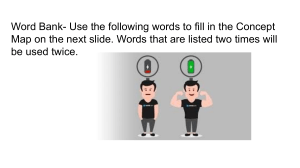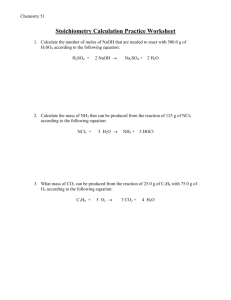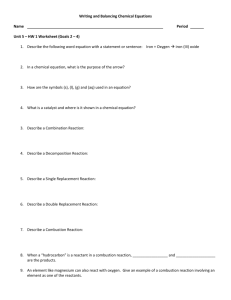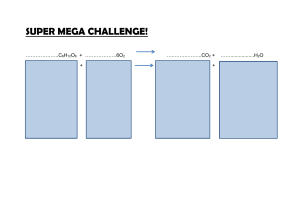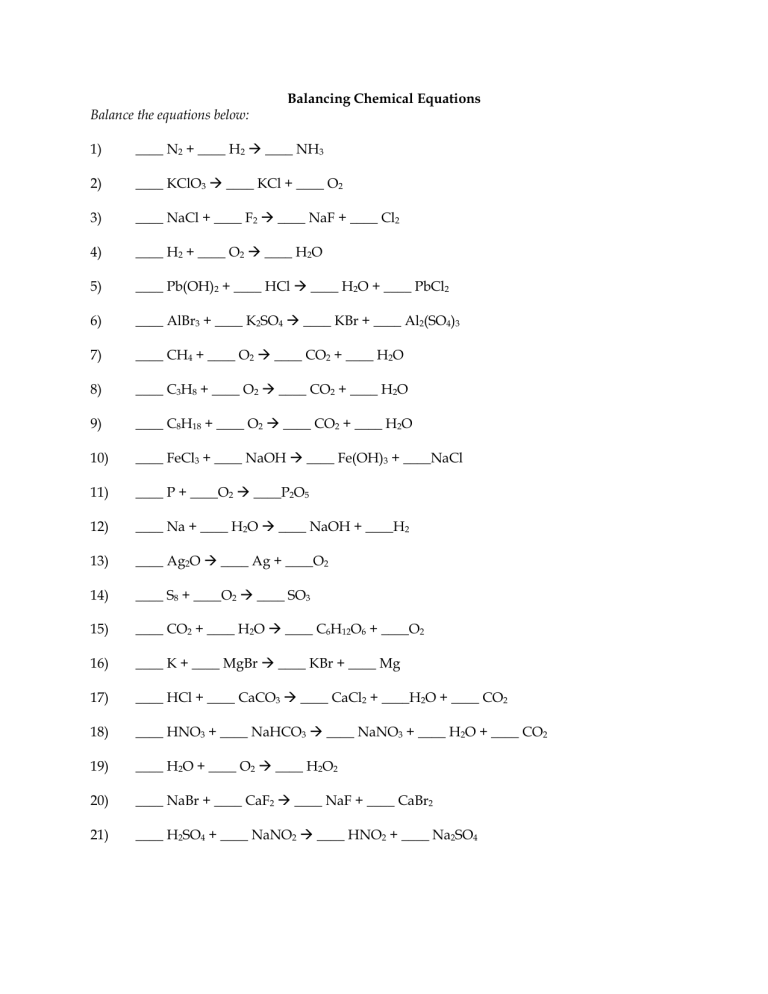
Balance the equations below: Balancing Chemical Equations 1) ____ N2 + ____ H2 ____ NH3 2) ____ KClO3 ____ KCl + ____ O2 3) ____ NaCl + ____ F2 ____ NaF + ____ Cl2 4) ____ H2 + ____ O2 ____ H2O 5) ____ Pb(OH)2 + ____ HCl ____ H2O + ____ PbCl2 6) ____ AlBr3 + ____ K2SO4 ____ KBr + ____ Al2(SO4)3 7) ____ CH4 + ____ O2 ____ CO2 + ____ H2O 8) ____ C3H8 + ____ O2 ____ CO2 + ____ H2O 9) ____ C8H18 + ____ O2 ____ CO2 + ____ H2O 10) ____ FeCl3 + ____ NaOH ____ Fe(OH)3 + ____NaCl 11) ____ P + ____O2 ____P2O5 12) ____ Na + ____ H2O ____ NaOH + ____H2 13) ____ Ag2O ____ Ag + ____O2 14) ____ S8 + ____O2 ____ SO3 15) ____ CO2 + ____ H2O ____ C6H12O6 + ____O2 16) ____ K + ____ MgBr ____ KBr + ____ Mg 17) ____ HCl + ____ CaCO3 ____ CaCl2 + ____H2O + ____ CO2 18) ____ HNO3 + ____ NaHCO3 ____ NaNO3 + ____ H2O + ____ CO2 19) ____ H2O + ____ O2 ____ H2O2 20) ____ NaBr + ____ CaF2 ____ NaF + ____ CaBr2 21) ____ H2SO4 + ____ NaNO2 ____ HNO2 + ____ Na2SO4 Writing Complete Equations Practice For each of the following problems, write complete chemical equations to describe the chemical process taking place. Important note: There are a few physical processes on this sheet – remember, you can’t write an equation for a physical process! 1) When lithium hydroxide pellets are added to a solution of sulfuric acid, lithium sulfate and water are formed. 2) If a copper coil is placed into a solution of silver nitrate, silver crystals form on the surface of the copper. Additionally, highly soluble copper (I) nitrate is generated. 3) When crystalline C6H12O6 is burned in oxygen, carbon dioxide and water vapor are formed. 4) Zinc and lead (II) nitrate react to form zinc nitrate and lead. 5) Aluminum bromide and chlorine gas react to form aluminum chloride and bromine gas. 6) Sodium phosphate and calcium chloride react to form calcium phosphate and sodium chloride. 7) Potassium metal and chlorine gas combine to form potassium chloride. 8) Aluminum and hydrochloric acid react to form aluminum chloride and hydrogen gas. 9) Calcium hydroxide and phosphoric acid react to form calcium phosphate and water. 10) Copper and sulfuric acid react to form copper (II) sulfate and water and sulfur dioxide. 11) Hydrogen gas and nitrogen monoxide react to form water and nitrogen gas. Six Types of Chemical Reactions Balance the following reactions and indicate which of the six types of chemical reaction are being represented: 1) ____ NaBr + ____ Ca(OH)2 ___ CaBr2 + ____ NaOH Type of reaction: _____________________________ 2) ____ NH3+ ____ H2SO4 ____ (NH4)2SO4 Type of reaction: _____________________________ 3) ____ C5H9O + ____ O2 ____ CO2 + ____ H2O Type of reaction: _____________________________ 4) ____ Pb + ____ H3PO4 ____ H2 + ____ Pb3(PO4)2 Type of reaction: _____________________________ 5) ____ Li3N + ____ NH4NO3 ___ LiNO3 + ___ (NH4)3N Type of reaction: _____________________________ 6) ____ HBr + ___ Al(OH)3 ___ H2O + ___ AlBr3 Type of reaction: _____________________________
